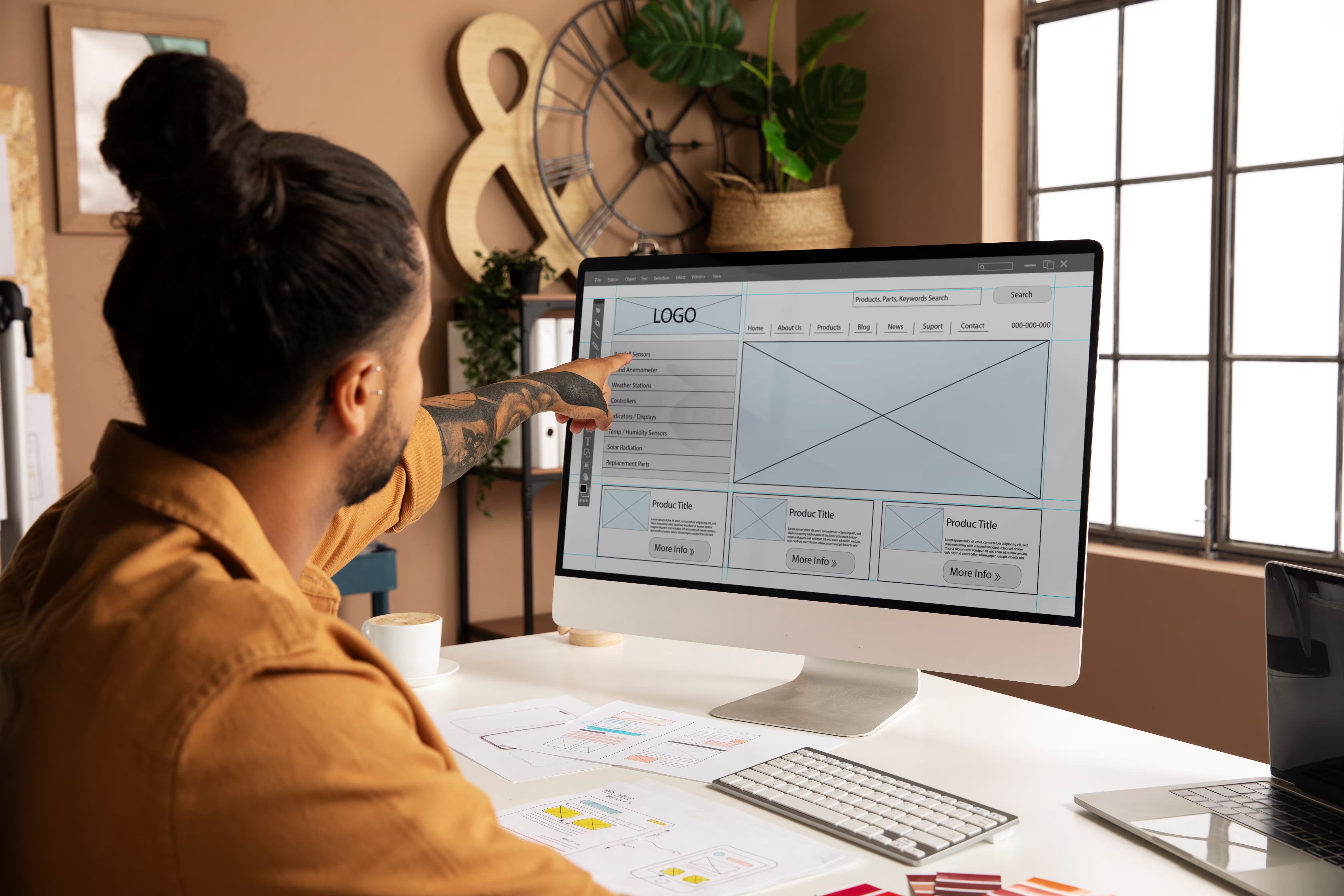Even for web designing, estimating the time required for a web design project is crucial for effective planning and meeting deadlines.
Webflow offers a versatile and user-friendly environment for building websites. However, predicting the exact duration of a project can be challenging due to various factors like project complexity, content volume, and team size.
This blog provides essential tips and insights to help you better evaluate the time needed for your Webflow development and design project, allowing for smoother project management and successful execution.


Webflow and time: Understanding the importance of setting a timeline for web development projects
Setting a timeline for Webflow development projects is significant as it serves as a roadmap for the entire project's execution and ensures a smooth and efficient workflow. Here are several reasons why establishing a timeline is crucial:
- Effective planning and organization:
A timeline allows web designers and developers to plan and organize tasks systematically. It helps them break down the project into manageable phases, assign responsibilities, and set achievable milestones, ensuring the project progresses coherently and on track.
- Meeting deadlines:
A timeline instills a sense of accountability and urgency, encouraging team members to adhere to project schedules and meet deadlines. This is particularly vital when clients have specific launch dates or time-sensitive goals.
- Resource allocation:
Timelines help allocate resources, including human resources, budget, and technology, efficiently. By understanding the time required for each task, teams can better allocate their resources to optimize productivity.
- Client expectations:
A well-communicated timeline sets clear expectations with clients regarding project delivery dates and milestones. It fosters transparency and helps manage client expectations throughout the development process.
- Risk management:
Timelines allow for the early detection of potential delays and difficulties. Project managers may proactively handle challenges, reduce risks, and, if necessary, create contingency plans with the help of a defined timetable.
- Collaboration and coordination:
A timeline helps team members collaborate and coordinate in larger teams or agencies, ensuring everyone is on the same page and working towards the same objective.
- Quality control:
Having a timeline allows sufficient time for testing, debugging, and revisions. It ensures that the final product undergoes thorough quality control checks before launch, reducing the likelihood of errors and glitches.
- Client communication:
A timeline is invaluable for communicating project progress with clients. Regular updates on milestones achieved and upcoming deliverables enhance client trust and satisfaction.

Understanding the factors that affect the Webflow timeline
Creating a successful Webflow project involves carefully considering various factors that can impact the Webflow project turnaround time. From initial planning to final launch, each stage requires attention and time allocation to ensure a seamless and efficient workflow, optimize Webflow design time, and deliver a high-quality, visually appealing, and fully functional website to your clients.
Set realistic expectations for your Webflow project
One of the fundamental steps in effectively managing the development timeline is to set realistic expectations right from the outset. Creating a successful Webflow project involves a comprehensive understanding of the various factors that can significantly impact the development timeline. From the initial conceptualization to the final launch, each stage requires careful consideration and strategic time allocation to ensure a seamless and efficient workflow.
Understanding the client's goals, target audience, and specific needs will help you set realistic expectations for the project's duration instead of going ahead with an unachievable deadline which will mar the quality of work.
Define the scope and complexity
Consider the project's functionality and design complexity. The scope and complexity of a Webflow project play a pivotal role in determining the overall timeline. Before delving into the development phase, evaluating the intricacy of the required functionality and design elements is essential.
Websites with advanced features, intricate animations, or complex user interfaces may demand more development time than straightforward designs.
Plan and wireframe
Invest time in creating detailed wireframes and mockups before diving into the actual design and development. This step lets stakeholders visualize the website's layout, user flow, and interactions.
Moreover, it helps identify potential challenges early on, reducing the risk of time-consuming revisions later. By dedicating sufficient time to planning and wireframing, designers can set a clear roadmap for the project, leading to a more efficient and focused development process.
Design and style in Webflow
The design and styling phase of the Webflow project is where creativity takes center stage. Allocate ample time for creating visually appealing and on-brand visual elements that resonate with the project's objectives.
Furthermore, consistent styling throughout the website enhances user experience and creates a cohesive feel. By allowing ample time for design and styling, designers can ensure that the website's aesthetics perfectly align with the client's brand identity and objectives.
Content creation and integration
Content is the lifeblood of any website, and integrating it seamlessly into the Webflow project is essential. Allocate sufficient time for content creation, ensuring it aligns with the website's design and functionality. Focus on balancing engaging visuals and informative text to keep users hooked.
Correctly displaying and formatting the content is crucial for optimal user experience, especially across various devices. By allocating dedicated time for content creation and integration, designers can deliver a well-rounded website that effectively communicates the client's message while complementing the design.
Building page layout
The page layout is the framework on which the entire website stands. Constructing a solid page layout is crucial for a seamless user experience, whether a simple landing page or a multi-page website. You will need considerable time to arrange visual elements, text, and interactive components to create a visually appealing and functional layout. Also, ensure that the layout is responsive, adapting gracefully to different screen sizes and devices.
Therefore be sure to allocate Webflow page development time separately. By dedicating sufficient time to building page layouts, designers can create websites that are aesthetically pleasing and easy to navigate and interact with.
Functionality and interactivity
Functionality and interactivity are essential aspects that enhance user engagement and overall user experience. Allocate time to add interactive elements like navigation menus, contact forms, image sliders, etc. Ensure that these elements function seamlessly and are intuitive for users to interact with.
By investing time in developing and testing these interactive features, designers can deliver a website that looks appealing and provides a dynamic and user-friendly experience.

Testing and debugging
Before the website goes live, thorough testing and debugging are imperative to identify and resolve potential issues. Allocate sufficient time for rigorous testing across different devices, browsers, and operating systems.
Address bugs, layout inconsistencies, or broken functionality to ensure a smooth and error-free user experience. By dedicating ample time to testing and debugging, designers can avoid the risk of launching a flawed website and maintain their reputation for delivering high-quality projects.
Client feedback and revisions
Incorporating client feedback and addressing revision requests is a standard part of the web development process. Allow sufficient time in the timeline to gather feedback, discuss changes, and implement revisions.
Iterative improvements based on feedback not only lead to a more polished website but also foster stronger client relationships and client satisfaction.
Launching the website
The result of all efforts leads to the much-anticipated moment of launching the website. Plan for the final launch and post-launch tasks, such as server setup, domain configuration, and search engine optimization (SEO).
Ensure a smooth transition from development to a live website by addressing last-minute details and conducting final checks. With a well-planned and executed launch, designers can celebrate the successful completion of the Webflow project and proudly present the website to the world.
Conclusion
Setting a timeline for Webflow development and design projects is essential for effective project management, on-time delivery, resource optimization, and client satisfaction. It empowers teams to work cohesively, manage risks, and produce high-quality websites within a defined timeframe.
Frequently asked questions
How long does it take to build a website using Webflow?
The time required to construct a website using Webflow is not fixed and varies based on the project's complexity, size, and customization demands. Simpler sites may be completed in a few days, while more intricate designs or larger projects could take several weeks to develop.
How can I estimate the project duration?
To estimate the project duration, assess the project requirements, break down tasks into milestones, and consider the experience and efficiency of your team.
Can I speed up the process of creating a Webflow website?
Yes, you can speed up creating a Webflow website by using pre-designed templates, optimizing your workflow through planning, and leveraging the collaborative capabilities of the platform.




















